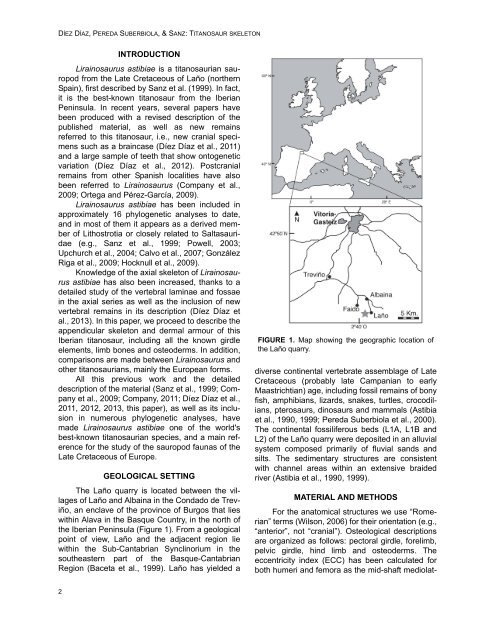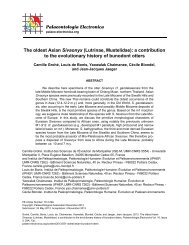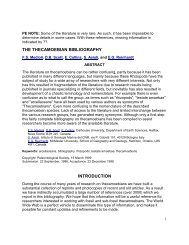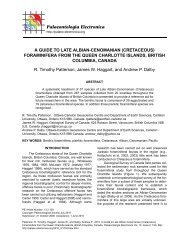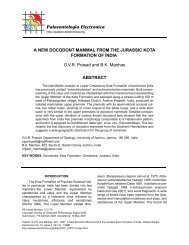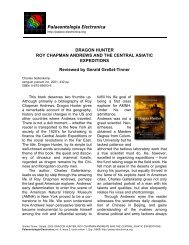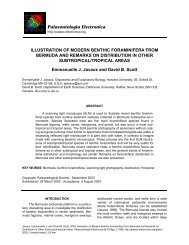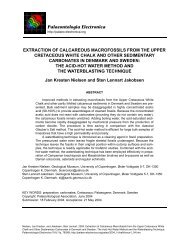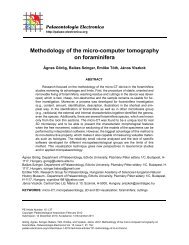Appendicular skeleton and dermal armour of the Late Cretaceous ...
Appendicular skeleton and dermal armour of the Late Cretaceous ...
Appendicular skeleton and dermal armour of the Late Cretaceous ...
You also want an ePaper? Increase the reach of your titles
YUMPU automatically turns print PDFs into web optimized ePapers that Google loves.
DÍEZ DÍAZ, PEREDA SUBERBIOLA, & SANZ: TITANOSAUR SKELETON<br />
INTRODUCTION<br />
Lirainosaurus astibiae is a titanosaurian sauropod<br />
from <strong>the</strong> <strong>Late</strong> <strong>Cretaceous</strong> <strong>of</strong> Laño (nor<strong>the</strong>rn<br />
Spain), first described by Sanz et al. (1999). In fact,<br />
it is <strong>the</strong> best-known titanosaur from <strong>the</strong> Iberian<br />
Peninsula. In recent years, several papers have<br />
been produced with a revised description <strong>of</strong> <strong>the</strong><br />
published material, as well as new remains<br />
referred to this titanosaur, i.e., new cranial specimens<br />
such as a braincase (Díez Díaz et al., 2011)<br />
<strong>and</strong> a large sample <strong>of</strong> teeth that show ontogenetic<br />
variation (Díez Díaz et al., 2012). Postcranial<br />
remains from o<strong>the</strong>r Spanish localities have also<br />
been referred to Lirainosaurus (Company et al.,<br />
2009; Ortega <strong>and</strong> Pérez-García, 2009).<br />
Lirainosaurus astibiae has been included in<br />
approximately 16 phylogenetic analyses to date,<br />
<strong>and</strong> in most <strong>of</strong> <strong>the</strong>m it appears as a derived member<br />
<strong>of</strong> Lithostrotia or closely related to Saltasauridae<br />
(e.g., Sanz et al., 1999; Powell, 2003;<br />
Upchurch et al., 2004; Calvo et al., 2007; González<br />
Riga et al., 2009; Hocknull et al., 2009).<br />
Knowledge <strong>of</strong> <strong>the</strong> axial <strong>skeleton</strong> <strong>of</strong> Lirainosaurus<br />
astibiae has also been increased, thanks to a<br />
detailed study <strong>of</strong> <strong>the</strong> vertebral laminae <strong>and</strong> fossae<br />
in <strong>the</strong> axial series as well as <strong>the</strong> inclusion <strong>of</strong> new<br />
vertebral remains in its description (Díez Díaz et<br />
al., 2013). In this paper, we proceed to describe <strong>the</strong><br />
appendicular <strong>skeleton</strong> <strong>and</strong> <strong>dermal</strong> <strong>armour</strong> <strong>of</strong> this<br />
Iberian titanosaur, including all <strong>the</strong> known girdle<br />
elements, limb bones <strong>and</strong> osteoderms. In addition,<br />
comparisons are made between Lirainosaurus <strong>and</strong><br />
o<strong>the</strong>r titanosaurians, mainly <strong>the</strong> European forms.<br />
All this previous work <strong>and</strong> <strong>the</strong> detailed<br />
description <strong>of</strong> <strong>the</strong> material (Sanz et al., 1999; Company<br />
et al., 2009; Company, 2011; Díez Díaz et al.,<br />
2011, 2012, 2013, this paper), as well as its inclusion<br />
in numerous phylogenetic analyses, have<br />
made Lirainosaurus astibiae one <strong>of</strong> <strong>the</strong> world's<br />
best-known titanosaurian species, <strong>and</strong> a main reference<br />
for <strong>the</strong> study <strong>of</strong> <strong>the</strong> sauropod faunas <strong>of</strong> <strong>the</strong><br />
<strong>Late</strong> <strong>Cretaceous</strong> <strong>of</strong> Europe.<br />
GEOLOGICAL SETTING<br />
The Laño quarry is located between <strong>the</strong> villages<br />
<strong>of</strong> Laño <strong>and</strong> Albaina in <strong>the</strong> Condado de Treviño,<br />
an enclave <strong>of</strong> <strong>the</strong> province <strong>of</strong> Burgos that lies<br />
within Alava in <strong>the</strong> Basque Country, in <strong>the</strong> north <strong>of</strong><br />
<strong>the</strong> Iberian Peninsula (Figure 1). From a geological<br />
point <strong>of</strong> view, Laño <strong>and</strong> <strong>the</strong> adjacent region lie<br />
within <strong>the</strong> Sub-Cantabrian Synclinorium in <strong>the</strong><br />
sou<strong>the</strong>astern part <strong>of</strong> <strong>the</strong> Basque-Cantabrian<br />
Region (Baceta et al., 1999). Laño has yielded a<br />
FIGURE 1. Map showing <strong>the</strong> geographic location <strong>of</strong><br />
<strong>the</strong> Laño quarry.<br />
diverse continental vertebrate assemblage <strong>of</strong> <strong>Late</strong><br />
<strong>Cretaceous</strong> (probably late Campanian to early<br />
Maastrichtian) age, including fossil remains <strong>of</strong> bony<br />
fish, amphibians, lizards, snakes, turtles, crocodilians,<br />
pterosaurs, dinosaurs <strong>and</strong> mammals (Astibia<br />
et al., 1990, 1999; Pereda Suberbiola et al., 2000).<br />
The continental fossiliferous beds (L1A, L1B <strong>and</strong><br />
L2) <strong>of</strong> <strong>the</strong> Laño quarry were deposited in an alluvial<br />
system composed primarily <strong>of</strong> fluvial s<strong>and</strong>s <strong>and</strong><br />
silts. The sedimentary structures are consistent<br />
with channel areas within an extensive braided<br />
river (Astibia et al., 1990, 1999).<br />
MATERIAL AND METHODS<br />
For <strong>the</strong> anatomical structures we use “Romerian”<br />
terms (Wilson, 2006) for <strong>the</strong>ir orientation (e.g.,<br />
“anterior”, not “cranial”). Osteological descriptions<br />
are organized as follows: pectoral girdle, forelimb,<br />
pelvic girdle, hind limb <strong>and</strong> osteoderms. The<br />
eccentricity index (ECC) has been calculated for<br />
both humeri <strong>and</strong> femora as <strong>the</strong> mid-shaft mediolat-<br />
2


